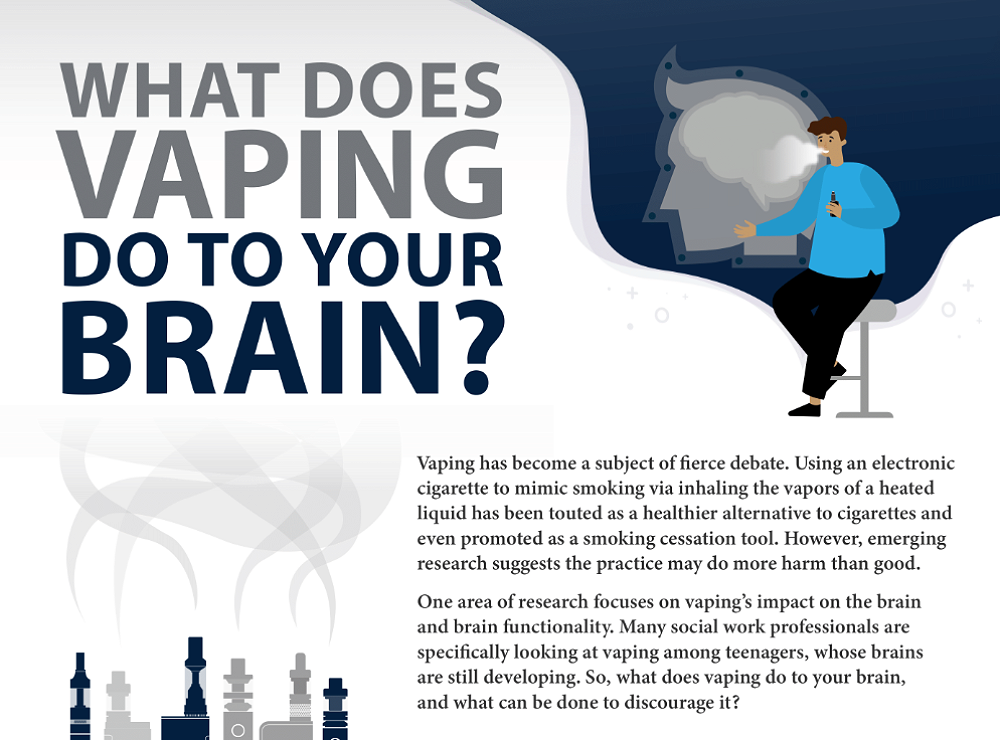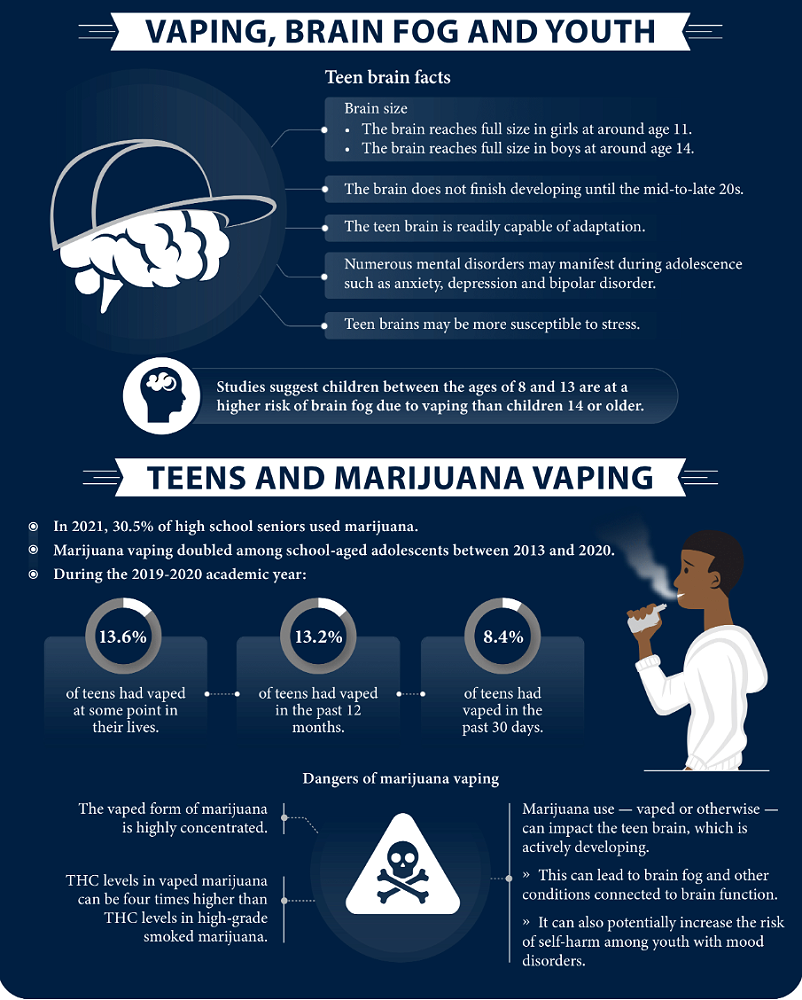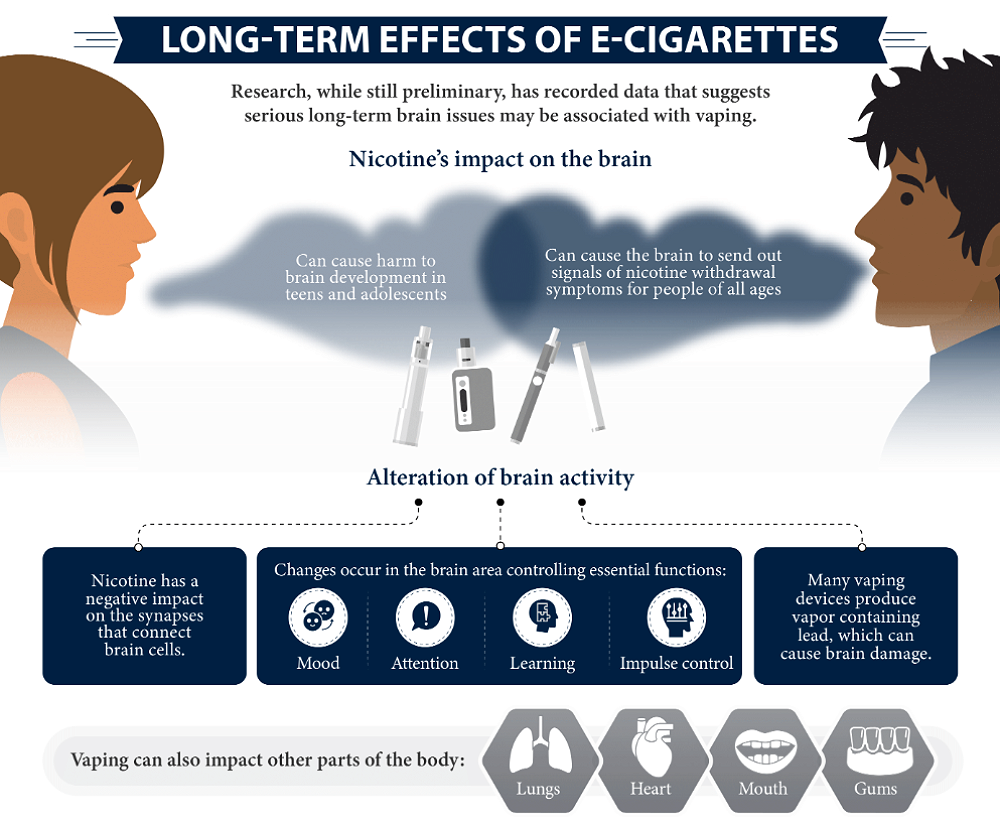
What Does Vaping Do to Your Brain? 
Click here to read this article online.
One area of research focuses on vaping’s impact on the brain and brain functionality. Many social work professionals are specifically looking at vaping among teenagers, whose brains are still developing. So, what does vaping do to your brain, and what can be done to discourage it?
To learn more, check out the infographic below, created by the University of Nevada, Reno’s Master of Social Work program.






Long-Term Effects of Vaping on the Brain
Although vaping has been promoted by some as a safer alternative to smoking, several components in e-cigarettes are similar to traditional cigarettes. The presence of chemicals like nicotine is among the reasons why studies suggest that vaping can contribute to long-term side effects that impact brain function.
Composition of E-Cigarettes
Nicotine is found in 99% of e-cigarettes. A highly addictive substance, it may increase adolescents’ risk of becoming addicted to other drugs.
However, nicotine is not the only concern. E-cigarettes also contain other potentially harmful substances. For example, e-cigarettes contain diacetyl, a chemical linked to lung disease. There could also be a link between vaping and cancer, as e-cigarettes also contain cancer-causing chemicals. Additionally, e-cigarettes contain volatile organic compounds, heavy metals such as lead or tin, and ultrafine particles, which can be inhaled deeply into the lungs.
Long-Term Effects of E-Cigarettes
Research, while still preliminary, has recorded data that suggests serious long-term brain issues may be associated with vaping. Some of this correlates with nicotine’s impact on the brain. Nicotine can cause harm to brain development in teens and adolescents, and can cause the brain to send out signals of nicotine withdrawal symptoms for people of all ages.
There are also concerns regarding the alteration of brain activity. Nicotine has a negative impact on the synapses that connect brain cells. This can spur changes in the brain area controlling essential functions such as mood, attention, learning and impulse control. Additionally, many vaping devices produce vapor containing lead, which can cause brain damage.
Vaping can also impact more than a person’s brain. The practice can have a negative impact on the lungs, heart, mouth and gums.
Vaping and Mental Health
While scientific study is ongoing, research suggests a correlation between vaping and negative mental health indicators. These indicators include mood and anxiety disorders, depressive symptoms, and suicidal ideation.
Social Work and Youth Vaping Prevention Strategies
The increased prevalence of vaping among adolescents is a concerning trend for social workers to address. Fortunately, these professionals can turn to several resources and tools to help reduce vaping usage.
The Challenges to Reducing Youth Vaping
Social workers need to clear many hurdles as they strive to reduce youth vaping. One of these hurdles is the acceptance of vaping in public areas. Another issue concerns the availability of and access to vaping products. Marketing, regulatory environments, cultural considerations and the misperception of vaping as low-risk present further challenges that must be taken into consideration.
Sources
Department of Justice/Drug Enforcement Administration, Vaping & Marijuana Concentrates
Journal of the Canadian Academy of Child and Adolescent Psychiatry, “Vaping and Mental Health”
Medical News Today, “E-cigarettes Can Increase Inflammation in the Brain, Heart, Lungs, and Colon”
National Institute of Mental Health, “The Teen Brain: 7 Things to Know”
National Institute on Drug Abuse, Cannabis (Marijuana)
NeuroscienceNews.com, “Vaping Could Cloud Your Thoughts”
Preventive Medicine Reports, “Smoking Cessation or Initiation: The Paradox of Vaping”
ScienceDaily, “Vaping Could Cloud Your Thoughts, New Studies Suggest”
VerywellMind, “What Is Brain Fog?”
